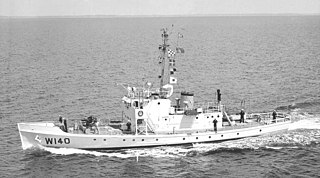Five ships of the United States Navy have borne the name Alert. During World War I, three ships held the name simultaneously.
USCGC Vigilant may refer to:

USCGC Tamaroa (WAT/WMEC-166), originally the United States Navy Cherokee-class fleet tugUSS Zuni (ATF-95), was a United States Coast Guard cutter. Following the U.S. Coast Guard custom of naming cutters in this class of ship after Native American tribes, she was named after the Tamaroa tribe of the Illiniwek tribal group.

The Island-class patrol boat is a class of cutters of the United States Coast Guard. 49 cutters of the class were built, of which 37 remain in commission. Their hull numbers are WPB-1301 through WPB-1349.
The Medium Endurance Cutter or WMEC is a type of United States Coast Guard Cutter mainly consisting of the 270-foot (82 m) Famous- and 210-foot (64 m) Reliance-class cutters. These larger cutters are under control of Area Commands. These cutters have adequate accommodations for crew to live on board and can do 6 to 8 week patrols.

USCGC Dauntless (WMEC-624) is a United States Coast Guard cutter, commissioned in 1968 and still on active duty.

The Wind-class icebreakers were a line of diesel electric-powered icebreakers in service with the United States Navy, United States Coast Guard, Royal Canadian Navy, Canadian Coast Guard and Soviet Navy from 1944 through the late 1970s. They were very effective ships: all except Eastwind served at least thirty years, and Northwind served in the USCG continuously for forty-four years. Considered the most technologically advanced icebreakers in the world when first built, the Wind-class icebreakers were also heavily armed; the first operator of the class was the United States Coast Guard, which used the vessels for much-needed coastal patrol off Greenland during World War II. Three of the vessels of the class, Westwind, Southwind, and the first Northwind all went on to serve temporarily for the Soviet Union under the Lend-Lease program, while two others were built for the United States Navy and another was built for the Royal Canadian Navy; all eight vessels were eventually transferred to the United States Coast Guard and the Canadian Coast Guard.
The history of the United States Coast Guard goes back to the United States Revenue Cutter Service, which was founded on 4 August 1790 as part of the Department of the Treasury. The Revenue Cutter Service and the United States Life-Saving Service were merged to become the Coast Guard per 14 U.S.C. § 1 which states: "The Coast Guard as established January 28, 1915, shall be a military service and a branch of the armed forces of the United States at all times." In 1939, the United States Lighthouse Service was merged into the Coast Guard. The Coast Guard itself was moved to the Department of Transportation in 1967, and on 01 March 2003 it became part of the Department of Homeland Security. However, under 14 U.S.C. § 3 as amended by section 211 of the Coast Guard and Maritime Transportation Act of 2006, upon the declaration of war and when Congress so directs in the declaration, or when the President directs, the Coast Guard operates as a service in the Department of the Navy.

USCGC Reliance (WMEC-615) is a United States Coast Guard medium endurance cutter. She is the first of the 210' Medium Endurance Cutter Fleet and the fourth Revenue Cutter / Coast Guard Cutter to bear the name Reliance. Constructed by Todd Shipyards in Houston, Texas and commissioned in 1964, she was originally homeported in Corpus Christi, Texas. Her duties included offshore oil rig inspections, fisheries, counter drug, alien migrant interdiction, marine pollution patrols, and search and rescue. Reliance has been homeported in Yorktown, Virginia, Port Canaveral, Florida and Portsmouth, New Hampshire. As of May 2014 she is stationed at the Pensacola Naval Air Station, Pensacola Florida.
USCGC Harriet Lane refers to three ships of the United States Coast Guard:
Two ships of the United States Coast Guard or its antecedent services have borne the name Sherman, in honor of John Sherman (1823–1900), who was Secretary of the Treasury during the Hayes administration (1877–1881).
USCGC Sebago has been the name of two cutters of the United States Coast Guard:
USCGC Tampa has been the name of four cutters of the United States Revenue Cutter Service and United States Coast Guard:
McCulloch or Hugh McCulloch has been the name of more than one ship of the United States Revenue-Marine, United States Revenue Cutter Service, or United States Coast Guard, and may refer to:
USCGC Campbell may refer to more than one United States Coast Guard ship.
USCGC Mendota has been the name of two cutters of the United States Coast Guard:

USCGC Reliance (WSC-150) was a 125-foot (38 m) steel hulled single screw Active-class patrol boat of the United States Coast Guard. She served from 1927 to 1948. The vessel
USCGC Chase can refer to the following ships of the United States Coast Guard:
USCGC Boutwell may refer to the following ships of the United States Coast Guard:
This page is based on this
Wikipedia article Text is available under the
CC BY-SA 4.0 license; additional terms may apply.
Images, videos and audio are available under their respective licenses.





